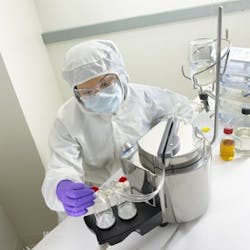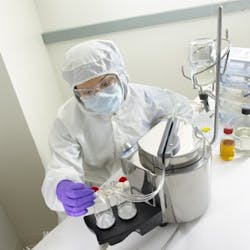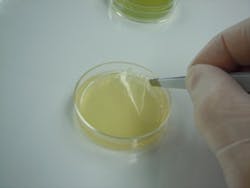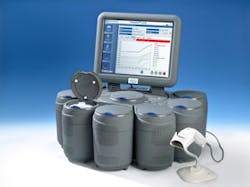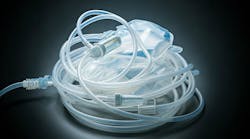Rapid microbiological methods (RMM’s) continue to grow in acceptance and significance in pharma, particularly for QA/QC testing. New rapid methods (see below) continue to flood the market, manufacturers test and validate them, and FDA continues to encourage their adoption. In its recently released (August 2011) strategic plan for the Advancement of Regulatory Science at FDA, the Agency emphasizes a need to reduce the risk of microbial contamination of products in the following manner:
a) Develop sensitive, rapid, high-throughput methods to detect, identify, and enumerate microbial contaminants and validate their utility in assessing product sterility;
b) Develop and evaluate methods for microbial inactivation/removal from pharmaceutical products that are not amenable to conventional methods of sterilization;
c) Evaluate the impact of specific manufacturing processes on microbial contamination; and
d) Develop reference materials for use by industry and academia to evaluate and validate novel methods for detecting microbial contamination.
The Agency has begun these activities on its own, following the testing and implementation already underway at major manufacturers. A recent CBER research document on sterility testing highlights the need to improve upon compendial methods in terms of time to results. It states that the compendial method “takes 14 days to provide results. This two-week period can be a significant limiting factor in the timely release of biologicals, particularly for pandemic vaccines and products with short shelf lives.” Researchers in the Division of Product Quality (DPQ) in the Office of Compliance and Biologics Quality (OCBQ) are evaluating various rapid microbial methods. They have, for instance, favorably compared several rapid tests—EMD Millipore’s Milliflex, bioMerieux’s BacT/ALERT, and BD’s BACTEC—to compendial methods. Each exhibited “equivalent sensitivity” at detection of lowest spiked microorganism level, while requiring significantly less time.
With an increasingly strong regulatory blessing, solution providers continue to push forward with new rapid micro technologies that are accelerating, and improving, drug QA/QC. What follows are some moves and announcements that various companies have made lately:
This summer, FDA accepted a Drug Master File (DMF) from BioLumix entitled “Microbiological Rapid Method for the Detection and Enumeration of Microorganisms in Pharmaceutical Products.” The DMF provides specific technical and regulatory information for companies planning to use the company’s Rapid Microbiological System. The DMF includes information about the technology’s accuracy, limits of detection, robustness, and equivalence to USP methods. “It offers simplified single-platform testing for all assays with a 48-hour Automated Certificate of Analysis, while avoiding any product interference,” says Kevin LaBrecque, director of sales and marketing.
BD (Becton, Dickinson and Company) recently introduced the FACSMicroCount flow cytometry system. (It purchased the rights to the product, previously known as the Micro PRO Microbial Detection System, from Advanced Analytical Technologies.) FACSMicroCount screens for bacteria, yeast, mold, spirochetes, Mycoplasma, and parasite cysts. Microorganisms are labeled with fluorescent dyes for detection, enumeration, and differentiation between living and dead organisms and enumeration. The samples are then injected into the flow cell in which microbes pass under a laser, causing them to emit fluorescence and scattered laser light. The new system complements the company’s other media and PCR products, says BD Diagnostics president Tom Polen.
In addition to its Milliflex rapid system, EMD Millipore (recently purchased by Merck KGaA) is offering a new Steritest EZ sterility testing device—designed for easier use and improved ergonomics. The devices are double-packed, allowing operators to open the outer bag in a cleanroom and bring the inner package into a laminar flow hood or isolator. Tests performed include: fertility and retention; sterility and sterility efficiency; membrane bubble point and flow rate; burst pressure; and toxicity and pyrogenicity.
In August, Merck KGaA also purchased the microbiology business unit of Biotest AG. Reports say that Merck is positioning itself as a major player in the global microbiology marketplace.
Celsis Rapid Detection has added a Staphylococcus aureus kit to its ReACT family of rRNA-based microbial assays for the rapid detection of objectionable organisms.
ReACT is a secondary assay used as a follow-up to positive Celsis AMPiScreen results. The AMPiScreen assay confirms the absence of bacteria, yeast and mold in roughly 24 hours, enabling the rapid release of “in spec” product into distribution days faster than traditional microbiological methods. When results are positive, ReACT can provide information about the nature of the event in two hours, the company says.
The ReACT assay “targets the unique rRNA signature of a species or group of microorganisms,” explains Andy Hearn, Senior Scientist at Celsis. The StaphAureus assay was developed at the request of customers who identified S. aureus as an objectionable organism that, if present, would affect product release. Celsis also offers a ReACTion Custom Probe program to develop assays for product- or facility-specific bugs or strains.
Rapid Micro Biosystems recently opened a demo center in Darmstadt, Germany, for showcasing and simulating its Growth Direct microbial enumeration system. (Roche’s Sven Deutschmann recently spoke about his company’s experimentation with Growth Direct at the PDA 2011 conference.) Julie Sperry, the company’s chief commercial officer, says that she has seen increased demand for rapid methods in both Europe and the U.S., but the driver is not regulatory, but rather a desire for these businesses to increase their Lab productivity, automate processes, and integrate to their LIMS systems.
Bret Barnhizer, CEO of NanoLogix, recently spoke with us about his company’s methods for rapid microbiological detection and ID, BioNanoPore and BioNanoFilter. BioNanoPore is a permeable membrane sandwiched between two layers of agar on a Petri plate, he says. It has a thicker layer of nutrient agar underneath and a thin film on top. The sample is placed on the film, then the membrane provides a platform for transferring microcolonies to a staining plate. Within 15 minutes of transfer, the stain will wick through the membrane and color the microcolonies. “It’s a tremendous time savings to detection, especially if someone’s just interested in total plate count,” he says.
BioNanoFilter, for detection and identification, has a nitrocellulose membrane with an antibody coating that reacts with whatever antigens might be in a sample. “BNF does both detection and, after a couple buffering processes, gives a spot-on antibody/antigen reaction and identification. So that’s gotten a lot of attention.”
What differentiates NanoLogix technologies? “Our technology only detects live cells, while PCR and other technologies detect live and dead cells,” Barnhizer says. Detection and determination of bacteria can be done within six hours, as borne out by studies at the University of Texas, he claims. It’s why like P&G Pharma and GSK are taking an interest, Barnhizer says.
Thermo Fisher Scientific has purchased TREK Diagnostic Systems to enhance its overall microbiological portfolio. Through the VersaTREK platforms, Thermo will offer automated systems for blood culture and the detection of mycobacteria. Through Sensititre, Thermo gains technology and expertise in the area of microbial resistance.
Pall’s Pallchek Rapid Microbiology System, based on ATP bioluminescence, has been used for a few years now for applications such as in-process or final sterility tests. Pall has also recently introduced the GeneDisc rapid system, a qPCR platform that, the company says, provides microbiological data in hours and is ideal for routine QC operations. The system has three components: a “DNA Extractor,” which prepares high-purity DNA for qPCR analysis from a broad range of samples; a plate with pre-loaded reagents for the qPCR reaction; and the “GeneDisc Cycler,” a real-time PCR platform for the “rapid, sensitive and specific” detection of microorganisms.
Current applications includes detection and quantification of E. coli, Salmonella spp., Pseudomonas aeruginosa, Staphylococcus aureus, Candida albicans and Aspergillus brasiliensis. Pall says it intends to add more to its family of assays for accelerating microbiology testing.
BioVigilant Systems has introduced its next generation Instantaneous Microbial Detection (IMD) system, for real-time environmental air monitoring in drug manufacturing environments. The IMD-A 300 and IMD-A 350 systems can immediately detect bacteria in the drug manufacturing process, the company says. IMD-A is based on fluorescence and Mie Scattering, using lasers to distinguish between inert and biologic particles. IMD-A systems continuously monitor the environment, as opposed to spot checks, sampling liters of air per minute. Visual and audible prompts warn operators when an action limit has been reached.
The company announced that it has filed Type V Drug Master Files (DMFs) for the IMD-A 300 series. Included in the filings are the test protocols and results of BioVigilant's testing against the USP<1223> Validation of Alternative Microbiological Methods guideline; environmental, vibration and shock test results; a review of the IMD-A systems' technology, functionality, subsystems, and operation; and BioVigilant's IQ/OQ/PQ protocols.
Accugenix offers the AccuPRO-ID for bacterial identification, “with greater accuracy and confidence than dated phenotypic methods offer,” the company claims. The method uses MALDI-TOF technology, based on mass spectrometry. The company also boasts a validated library based on its own genetic testing and frequency of occurrence data from over 500,000 microorganisms identified during the past decade.
Mark Calmann, Accugenix’s Senior Product Manager, presented a poster at the PDA conference earlier this year about the library. Most companies perform standard technical and financial reviews when choosing microbiological identification systems, he noted. But a key component of this review that is often neglected is the importance of the depth of a method’s library, and the accuracy and relevancy of entries used to obtain species-level identification.
